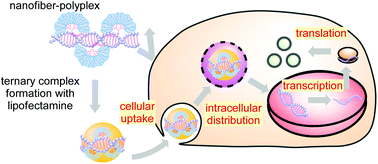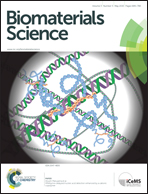Gene expression of ternary complexes through the compaction of nanofiber-polyplexes by mixing with lipofectamine
Abstract
For the development of an effective nonviral gene vector, ternary complexes were prepared through the compaction of nanofiber-polyplexes. These were formed using pDNA and a head-tail type polycation bearing a multi-arm poly(ethylene glycol) head and a poly(L-lysine) tail, and this strategy was based on the crowding effect of poly(ethylene glycol) in the polyplex. Mixing was carried out using a cationic lipid (lipofectamine), which is a commercially available transfection reagent. Through ternary complex formation, the elongated morphology of nanofiber-polyplexes was found to compact into a spherical shape with an average diameter of ca. 100 nm. Accompanying ternary complex formation, the compaction of the nanofiber-polyplexes can improve cellular uptake and helps the ternary complex to retain its smooth transcription/translation process, which is characteristic of nanofiber-polyplexes. As a result, ternary complexes prepared at an optimal mixing ratio exhibit a high transfection efficiency compared with lipofectamine lipoplexes.


 Please wait while we load your content...
Please wait while we load your content...